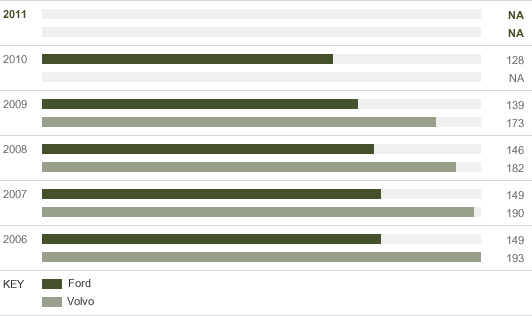Data
Fuel Economy and CO2 Emissions
Data on this page
A. Ford U.S. Corporate Average Fuel Economy
Miles per gallon

| 2006 | 2007 | 2008 | 2009 | 2010 | 2011 | |
|---|---|---|---|---|---|---|
| Cars (domestic and import) | 28.2 | 29.1 | 30.3 | 31.2 | 32.6 | 32.7 |
| Trucks | 21.1 | 22.3 | 23.6 | 24.6 | 24.1 | 24.2 |
| Combined car and truck fleet | 23.8 | 25.3 | 26.0 | 27.1 | 26.9 | 27.8 |
- Reported to regulatory authorities
B. Ford U.S. CO2 Tailpipe Emissions per Vehicle (Combined Car and Truck Fleet Average CO2 Emissions)
Grams per mile

| 2006 | 2007 | 2008 | 2009 | 2010 | 2011 |
|---|---|---|---|---|---|
| 371 | 352 | 340 | 326 | 329 | 318 |
Notes to Data
Improvement is reflected in decreasing grams per mile.
C. Ford Europe CO2 Tailpipe Emissions per Vehicle
Grams per kilometer

| 2006 | 2007 | 2008 | 2009 | 2010 | 2011 | |
|---|---|---|---|---|---|---|
| Ford | 149 | 149 | 146 | 139 | 128 | NA |
| Volvo | 193 | 190 | 182 | 173 | NA | NA |
Notes to Data
The 2011 calendar-year fleet-wide CO2 emissions data for our European fleet will be available in November 2012. Improvement is reflected in decreasing grams per kilometer. Based on production data for European markets. European and U.S. fleet CO2 emissions are not directly comparable because they are calculated in different units and because they are assessed based on different drive cycles. In 2009, we switched from reporting European vehicle CO2 emissions as a percent of a 1995 base to reporting actual fleet average CO2 emissions, to parallel our reporting for other regions.
Analysis
In Europe, we have reduced the average CO2 emissions of 2010 model year vehicles by 8.1 percent compared to the 2006 model year (not including Volvo). We have achieved this through the introduction of a variety of innovations, such as advanced common rail diesel engines available across the European model range – including the ECOnetic range of low-CO2 vehicles – and the use of lightweight materials.
